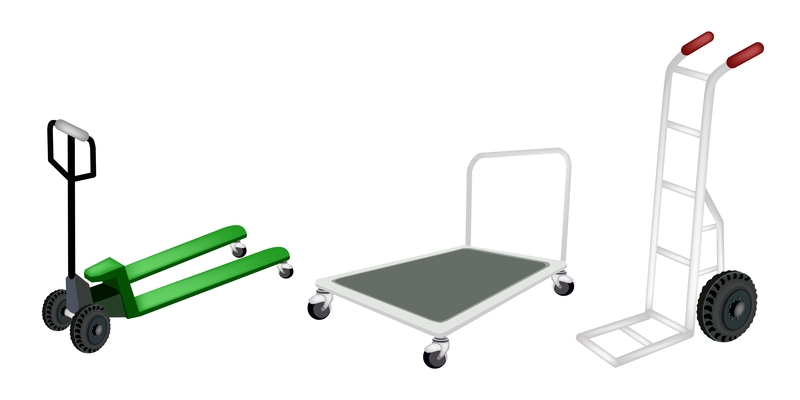How to Efficiently Transport Your Bed and Mattress
Posted on 21/06/2025
How to Efficiently Transport Your Bed and Mattress
Moving represents a fresh start, but transporting large furniture, particularly your bed and mattress, can be one of the more daunting challenges. Whether relocating across town or to another state, ensuring your sleep essentials arrive in top shape is crucial for making your new house a home. This comprehensive guide reveals step-by-step strategies on how to efficiently transport your bed and mattress with minimal stress, damage, or delay.
Why Safe Bed and Mattress Transport Matters
Your bed frame and mattress are investments in your comfort and well-being. Mishandling them can lead to:
- Permanent damage--such as bent frames, torn fabric, or ruined springs
- Hygiene risks--exposure to dirt, moisture, and contaminants during transit
- Loss of warranty--improper transportation might void your mattress warranty
- High replacement costs--requiring unnecessary purchases for your new home
Protecting your sleep investment is simple when you follow expert tips and proven moving methods.

Pre-Move Preparation: What to Do Before Moving Your Bed and Mattress
1. Gather the Right Supplies
The first step in efficiently transporting your bed and mattress is collecting proper packing materials. Here's what you'll need:
- Mattress bag or heavy-duty plastic cover
- Furniture blankets or moving pads
- Packing tape (industrial-strength for securing covers and components)
- Bubble wrap for delicate components
- Tool kit (screwdriver, wrench, Allen key) for disassembly
- Zip or plastic bags for screws & hardware
- Labels and markers for organization
- Straps or rope to secure items during transit
2. Measure Your Bed, Mattress, and Pathways
Measuring saves time and prevents accidents. Record the dimensions of your mattress, bed frame components, and all access points (hallways, doors, stairs, elevators, even moving truck openings). This ensures you'll know if disassembly is required and if your bed can be moved safely through your space.
3. Clean and Inspect
Clean your mattress and all bed parts before packing. Dust, vacuum, and spot-clean each piece so you aren't moving dirt into your new home. Inspect for any damage and photograph items for insurance purposes, should any claim arise post-move.
Mattress Moving: The Right Way
1. Remove Bedding and Accessories
Strip your bed completely, including sheets, pillows, mattress toppers, and protectors. Pack bedding separately in sealed bags or boxes for easier moving. This will also make the mattress lighter and more manageable.
2. Protect Your Mattress
- Encasing your mattress is non-negotiable. Slip it into a high-quality mattress bag or cover, available from moving supply stores or online retailers.
- Seal the ends of the bag with packing tape to prevent dust and moisture from sneaking in.
- For long-distance or outdoor transportation, double-wrap with moving blankets for added protection.
Pro Tip: If your mattress is particularly heavy or you've invested in a premium model (such as a memory foam or hybrid), opt for a thick, tear-resistant cover to avoid accidental rips during the move.
3. Handling and Carrying Your Mattress
Never drag or fold your mattress excessively--this can damage the internal structure or void the warranty. With a helper, lift and carry the mattress by its sides, keeping it vertical when possible. If you must navigate stairs or tight spaces, proceed slowly and communicate with your assistant.
- Use mattress moving straps for extra grip and back support.
- If moving solo, consider a mattress sling device.
4. Mattress Transportation in a Vehicle
Flat transport is usually best, but some mattresses (like innerspring, latex, or hybrids) can briefly stand on their side if room is tight. Check the manufacturer's guidelines for your specific mattress type.
- Inside a moving truck: Place the mattress flat on the truck floor or against a wall, well-secured with straps or ropes so it doesn't shift in transit.
- In a pickup truck: Lay the mattress flat in the bed, use tarps in addition to the cover, and strap tightly to prevent wind damage.
- Avoid roof transport: Never tie a mattress to the roof of a car except as a last resort--it's risky, can harm the mattress, and may violate local laws.
How to Transport a Bed Frame
1. Disassemble the Bed Frame
- Remove the mattress and box spring first.
- Unscrew or unbolt side rails, headboard, and footboard. Keep all small parts (hardware, bolts, washers) in labeled plastic zip bags.
- Take photos of each step during disassembly, especially complex bed frames, to ease reassembly later.
- Bundle bed frame pieces together with moving blankets and tape for protection during transit.
If your bed frame is very heavy, ornate, or an antique, consider professional movers. They have experience with bulky or delicate furniture.
2. Protect Bed Components
- Wrap everything--rails, slats, and headboard--in moving blankets or thick padding. Secure with packing tape (never tape directly on wood or painted surfaces).
- Label each piece (e.g., "Left Headboard Leg") for fast reassembly.
3. Loading the Vehicle
- Lay large bed components flat against the sides of your moving truck or van.
- Do not stack heavy items on top of bed parts to prevent warping.
- Secure frames with straps if there's risk of shifting.
What to Do When Moving Unique Bed Types
Platform Beds, Adjustable Bases, Bunk Beds, and More
Every bed style may need unique handling. For example:
- Adjustable bed bases often have motors and electronics. Unplug and remove the power supply, protect fragile mechanisms, and pack the remote separately.
- Bunk beds are bulky--disassemble completely and label parts clearly.
- Platform beds may have additional hardware or frames--keep all instructions and components organized.
When in doubt, refer to the user manual or manufacturer's website for moving tips that protect warranties and preserve safe functioning.
Professional Movers vs. DIY: Which Is Best for Bed and Mattress Transport?
Why Hire Professionals?
- Expert handling: Movers know how to disassemble, pad, and secure beds and mattresses efficiently.
- Heavy lifting: They reduce your risk of injury.
- Insurance: Professional moving companies typically offer coverage for damage in transit.
- Speed: Experienced teams get the work done much faster than DIY moves.
When DIY Makes Sense
- You have a simple bed frame and lightweight mattress.
- You're moving a short distance and have reliable help.
- You want to save money and are confident in your moving skills.
Weigh your timeline, budget, and complexity when choosing between professional movers and DIY. For especially valuable or delicate beds and mattresses, err on the side of caution.
Tips for Efficient Bed and Mattress Transportation
- Don't rush. Schedule sufficient time for careful disassembly, packing, and transport.
- Enlist assistance. Beds and mattresses are awkward and heavy--having a helper makes the process safer.
- Label everything. Clear labels save hours during reassembly.
- Check truck space in advance. This prevents last-minute repacking.
- Protect against the weather. Mattresses can be ruined by water exposure--always use covers.
- Prioritize unloading the bed and mattress at your new home. You'll want to rest after a long day of unpacking!

Frequently Asked Questions
Can I transport a memory foam mattress on its side?
Memory foam mattresses should be kept flat whenever possible. Prolonged vertical storage can distort their shape. For brief moves, standing the mattress on its side is acceptable if flat space is limited, but lay it flat as soon as possible at your destination.
How do I move a king-size mattress?
King-size mattresses are heavier and floppier than standard sizes. Use a high-quality, reinforced mattress bag, lifting straps, and always have help. Secure it flat in the moving truck, and avoid sharp bends.
Is it safe to transport a mattress on my car roof?
It's generally not advised. Roof transport is risky--strong winds, imbalanced loads, and weather present dangers both to your mattress and others on the road.
How long can my mattress stay wrapped up?
Ideally, limit the time a mattress remains sealed in plastic to a few days. Prolonged wrapping may trap moisture, especially in humid climates, leading to mildew or odors.
What about moving box springs?
Box springs move like mattresses: cover them thoroughly, carry vertically with a helper, and secure them in the truck to prevent shifting.
Conclusion: Rest Easy with Smart Mattress and Bed Transport
Moving your bedroom furniture doesn't have to be stressful! When you plan carefully, choose suitable protective materials, and use proper handling techniques, you ensure your bed and mattress arrive--clean, undamaged, and ready for your next great night's sleep. Efficient transport today leads to excellent rest tomorrow. Happy moving!



